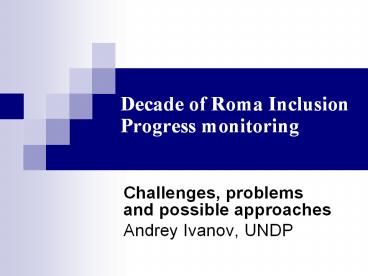Decade of Roma Inclusion Progress monitoring PowerPoint PPT Presentation
1 / 10
Title: Decade of Roma Inclusion Progress monitoring
1
Decade of Roma Inclusion Progress monitoring
- Challenges, problems and possible approaches
- Andrey Ivanov, UNDP
2
Why evidence is crucial?
- The Decade MDGs for one of the most vulnerable
groups, the Roma - Clear commitment from governments with strict
time-frame set (2005-2015) - Major priority areas - poverty, employment,
education, health and housing - National action plans for Roma Decades developed
and Decade secretariats established in 2003-2005
3
The Decade as data challenge
- Intends to address the needs of fluid population.
Unclear what to put in the denominator when
computing various indicators - NAPs need reliable estimate to allocate
resources. - Both sides governments and Roma often speak
different languages. High level of mistrust
(pre-divorce phenomenon) - Susceptible to manipulation by both sides
- Government has incentives to report success
- Roma CSO have incentives to report failures
4
The approaches so far
- NAPs usually lack clear indicators. Input,
output, outcome and impact often confused (not
clear deliberately or not) - The monitoring role taken over by
non-governmental actors - The Decade Watch published in 2007, assessment
of the inputs to the Decade implementation as
seen by Roma CSOs - WB/OSI/UNDP Decade indicators working group
working since 2007 on internationally comparable
indicators - UNDP two rounds of data collection (2002 and
2004) and increasing supporting national-level
efforts for NAPs implementation - The current pattern may reinforce the mutual
distrust of parties directly involved
(governments and Roma civil society)
5
UNDP approach to Decade monitoring
- It is neither possible nor reasonable to invent
and implement Roma indicators. - For the monitoring of the Decade a standard sets
of socio-economic and human development
indicators should be applied - Standard indicators must be fed with ethnically
disaggregated data and the challenge boils down
to availability of such data - Indicators should follow the policy purpose
- Anything too simple is inevitably misleading
- Choosing between national adequacy and
international comparability the former is a
priority (following the MDGs pattern)
6
UNDP approach to data process
- National actors should be supported and not
substituted in data issues - International organizations can test the grounds
but not take over - There is a lot of data available, the challenge
is to use it in creative way. Some possible
approaches include - Disaggregating hard statistics using personal
identification numbers as a common denominator
(key link) for mutually complementing data sets - Disaggregating hard statistics using territorial
tags as ethnic markers combining quantitative
data with qualitative information. Gives estimate
of the real needs (adequate for policy-making) - Extending the samples of regular sample based
surveys with ethnic boosters - Custom on the spot surveys conducted among
recipients of different social services - Collecting data at a community level by
Community-based data collectors and monitors - Using measurable proxies that are strongly
correlated with Roma identity to estimate
progress in sectoral priorities of the Decade
7
UNDP approach to NAPs
- Consistently distinguish input, output, outcome,
and impact indicators - Put different focus on different levels of
monitoring (central and local) - Integrate the monitoring functions into the whole
NAP implementation strategy (so far it is
detached) - Support local governments in data collection,
data analysis and data application capacities
(skills to understand and use data are even more
important than the existence of data per se) - Regularly update of the NAPs with ME components
with necessary indicators - Include Roma in the whole cycle
(collection-processing-analysis-policy
modification)
8
Comparing different approaches do data
disaggregation
9
Comparing different approaches do data
disaggregation
10
Conclusions
- Defendable indicators for progress monitoring are
crucial both for policy design and policy impact
assessment. Without such indicators the Decade
may fail in its promises - Disaggregating statistical data by ethnicity is
possible even when exact number of Roma
population is unclear. Constructing ethnically
sensitive indicators is possible both national
and internationally comparable - Problems exist, however they are less of
methodological, technical or financial but rather
of political nature - Given the concerns regarding individual data
integrity, such disaggregation and construction
of indicators should be done by specially
appointed agency operating in line within clear
legislation on the matter. National statistics
are best suited for such a role.

